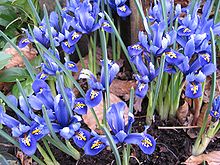Iris reticulata
| Iris reticulata | |
|---|---|

| |
| Scientific classification | |
| Kingdom: | Plantae |
| Clade: | Tracheophytes |
| Clade: | Angiosperms |
| Clade: | Monocots |
| Order: | Asparagales |
| Family: | Iridaceae |
| Genus: | Iris |
| Subgenus: | Iris subg. Hermodactyloides |
| Section: | Iris sect. Reticulatae |
| Species: | I. reticulata
|
| Binomial name | |
| Iris reticulata | |
| Synonyms[1] | |
| |
Iris reticulata, the netted iris or golden netted iris,[2] is a species of flowering plant in the family Iridaceae.
Description
[edit]The reticulata group of irises is characterised by a fibrous net surrounding the bulb. They are small plants to 15 centimetres (5.9 in), with tubular, sharply-pointed, ribbed leaves, and flowers of yellow, blue or purple with an orange blaze on the falls, appearing in early spring. They are hardy, but prefer a well-drained sunny position in soil which dries out in summer; they are therefore suitable for a rock or gravel garden.[3]
Iris reticulata has spherical to drop shaped bulbs,[4]that are coated with a solid brown fiberous network.[5]
The leaves appear after flowering,[5] it has 10 cm (3.9 in) high stems.[6][7]
In the Northern Hemisphere it blooms in the winter, between November and January,[8][6] or sometimes in February.[5] The flowers are around 2.5–3 cm (0.98–1.18 in) wide.[5][7] The flowers are much smaller than those of other Reticulata irises.[5]
Like other irises, it has two pairs of petals, three large sepals (outer petals), known as the "falls", and three inner, smaller petals (or tepals), known as the "standards".[9]: 17 They come in shades of blue, from clear blue,[8][6][10] to dark blue and purple.[5] The falls have a bright yellow ridge,[8] or orange mark.[5][10]
Distribution and habitat
[edit]Iris reticulata is native to temperate areas of western Asia from eastern Turkey to Iran,[11] but cultivated widely in temperate regions.[12][5]
Range
[edit]Found in the Hyrcanian woods,[6] along the southern coast of the Caspian Sea from Azerbaijan to Iran.[4][12][5]
Habitat
[edit]It is found growing in the mountains along the Caspian Sea.[5]
Cultivation
[edit]It prefers to grow in sunny sites, on rocky soils that dry out completely in summer.[5]
As it is not very hardy, but it can withstand strong frosts of short duration.[5] Although it is thought to be best grown in the UK and in America, within a bulb frame or alpine house,[8] to keep the soils dry.[5] It also needs a dry, summer dormancy of several months.[5]
A specimen of Iris hyrcana won the Farrer Medal at the AGS Caerleon Show, in South Wales, shown by Bob and Rannveig Wallis.[13]
The following cultivars have received the Royal Horticultural Society's Award of Garden Merit:
There is a known variety called Iris reticulata var. bakeriana (also known as Iris bakeriana).
Biochemistry
[edit]As most irises are diploid, having two sets of chromosomes, this can be used to identify hybrids and classification of groupings.[9]: 18 It was counted as 2n=20,[5]
Toxicity
[edit]Like many other irises, most parts of the plant are poisonous (rhizome and leaves), if mistakenly ingested can cause stomach pains and vomiting. Also handling the plant may cause a skin irritation or an allergic reaction.[17]
References
[edit]- ^ "Iris reticulata M.Bieb. is an accepted name". theplantlist.org (The Plant List). 23 March 2013. Retrieved 28 March 2015.
- ^ Rudy J. Favretti and Joy P. Favretti Landscapes and Gardens for Historic Buildings: A Handbook for Reproducing and creating authentic landscape settings, p. 145, at Google Books
- ^ RHS A-Z encyclopedia of garden plants. United Kingdom: Dorling Kindersley. 2008. p. 1136. ISBN 978-1405332965.
- ^ a b "Iris hyrcana". encyclopaedia.alpinegardensociety.net. Retrieved 18 July 2014.
- ^ a b c d e f g h i j k l m n o "Chapter III bulbous iris". irisbotanique.over-blog.com. Retrieved 21 March 2018.
- ^ a b c d "IRIS HYRCANA". cgf.net. Retrieved 21 March 2018.
- ^ a b "(SPEC) hyrcana". wiki.irises.org (American Iris Society). Retrieved 18 July 2014.
- ^ a b c d "Reticulata Irises". www.pacificbulbsociety.org. 11 May 2014. Retrieved 14 July 2014.
- ^ a b Austin, Claire (2005). Irises; A Garden Encyclopedia. Timber Press. ISBN 978-0-88192-730-6.
- ^ a b "Iris hyrcana". rareplants.co.uk. Retrieved 21 March 2018.
- ^ "Iris reticulata M.Bieb. | Plants of the World Online | Kew Science".
- ^ a b "Iris reticulata". Germplasm Resources Information Network. Agricultural Research Service, United States Department of Agriculture. Retrieved 23 February 2018.
- ^ "Iris hyrcana won the Farrer Medal at the AGS Caerleon Show, shown by Bob & Rannveig Wallis". twitter.com. 15 Feb 2014. Retrieved 18 July 2014.
- ^ "Iris 'George'". RHS. Retrieved 8 June 2020.
- ^ "Iris 'Katharine Hodgkin'". RHS. Retrieved 9 June 2020.
- ^ "Iris 'Pixie'". RHS. Retrieved 8 June 2020.
- ^ David G Spoerke and Susan C. Smolinske Toxicity of Houseplants, p. 236, at Google Books
- Komarov, V. L. et al., eds. 1934–1964. Flora SSSR. [lists as I. hyrcana (Woronow)]
- Mathew, B. 1981. The Iris. 177
